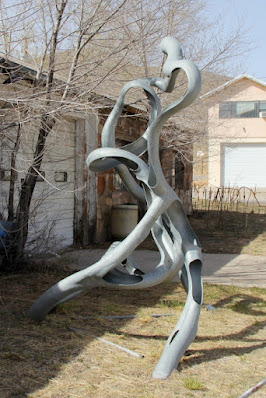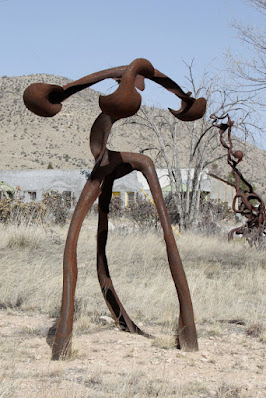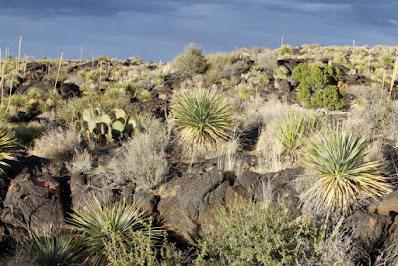Tinnie, New Mexico, is known for the unique tubular art sculptures that are scattered about the area surrounding US Highway 70. Some of the sculptures even have parts that rotate in the wind.
The town of Lincoln (population 189) is now a New Mexico State Monument and most of the historic buildings are managed by the Lincoln Historic Site Department. Lincoln is the most visited state monument in New Mexico and cannot be missed when traveling on US Highway 380 because it is the only street in town. Maybe that is why it is the most visited!
Lincoln is considered to be "frozen in time" with 17 structures and outbuildings still existing from the 1870s and 1880s. The buildings are examples of American Southwest Territorial-Style-adobe architecture and some of the buildings are open to the public. There are information signs on many of the buildings and sites to help visitors better understand the history of the area.
One of the most violent periods in New Mexico history is connected to Lincoln. The Lincoln County War started here as a result of two merchants fighting over profits from the sale of dry goods and cattle.
James Dolan had a dry good store monopoly when John Tunstall opened a competitive store. To protect their interests, both sides hired lawmen, businessmen, ranch hands, and criminal gangs.
Dolan hired local Sheriff Brady and the Jesse Evans Gang while Tunstall hired the Deputy US Marshall and other gunmen that called themselves the Lincoln County Regulators.
The war started when a member of the Evans Gang shot and killed Tunstall in "cold blood." In revenge, the Regulators killed Sheriff Brady. For several months, each side shot and killed members of the other side in revenge for the prior killings.
Finally, the two large forces met in the town of Lincoln and had a shootout that lasted for three days. To restore peace, the US Army was called in to stop the gunfights. The shootout became known as the Battle of Lincoln.
After arrival of the Army, less-desirable participants fled the area because they were fearful of being arrested and charged with some of the cold-blooded murders. One of the Regulators that escaped was Billy the Kid (aka William Bonney).
Billy the Kid was an outlaw and gunfighter of the old west and is alleged to have killed 21 men before he was shot and killed when he was 21-years old. He is considered to be one of the most famous outlaw figures in American history.
There are many stories and books about Billy the Kid, and he has been characterized in over 50 movies. During the heyday of western novels, he was sometimes portrayed as a good guy who was falsely accused of a killing. In reality, he was found guilty of murdering several people; but escaped before his hanging. He and his two partners were then tracked down and killed by Sheriff Pat Garrett.
 |
| Picture by Kolohe |
 |
| Picture by Kolohe |
 |
| Picture by Kolohe |
 |
| Picture by Kolohe |
There are two museum buildings that contain collections of historical items from the 1800s, including items from the Lincoln County War. Most people have seen the famous picture of Billy the Kid, but someone made an amazing metal image of the picture that is now located by one of the museum buildings.
 |
| Photographer Unknown |
 |
| Picture by Kolohe |
 |
| Picture by Kolohe |
 |
| Picture by Kolohe |
 |
| Picture by Kolohe |
 |
| Picture by Kolohe |
Fort Stanton was built in 1855 to protect settlers from the Mescalero Apache Indians. After the Apache Wars ended, the fort was transferred to the Marine Hospital Service for the treatment of veterans.
Then, during WW II the property was used as a detention center for Japanese Americans that had been arrested as "enemy aliens" and 411 German nationals taken from the luxury liner Columbus. The Japanese and Germans were kept separate and not allowed to socialize. After the war, the post stayed open until 1953, and was then abandoned.
In 2008, the State of New Mexico started restorations on the property for the preservation of the fort as Fort Stanton State Monument, and in 2009 U.S. Congress designated 25,000 acres of land surrounding the fort as a National Conservation Area (NCA). The NCA now has over 90 miles of multi-use trails for horseback riding, mountain biking, and hiking.
 |
| Picture by Kolohe |
 |
| Picture by Kolohe |
 |
| Picture by Kolohe |
 |
| Picture by Kolohe |
 |
| Picture by Kolohe |
 |
| Picture by Kolohe |
 |
| Picture by Kolohe |
 |
| Picture by Kolohe |
In 1950, a small five-pound American Black Bear was found with burned paws and hind legs after a forest fire near Capitan, New Mexico. He was treated for his burns by a veterinarian and became know as Smokey Bear (aka, Smokey the Bear). He was later transferred to the National Zoo in Washington, D.C., where he lived for 26 years
During Smokey's lifetime, he was featured in various advertisements for the U.S. Forest Service Wildfire Prevention Campaign, which was the longest-running public service announcement campaign in United States History.
Smokey died November 9, 1976, and was sent home to be buried in Capitan, New Mexico, near where he was found in 1950.
 |
| Picture by Kolohe |
 |
| Picture by Kolohe |
 |
| Picture by Kolohe |
 |
| Picture by Kolohe |
 |
| Smokey's grave - Picture by Kolohe |
 |
| Picture by Kolohe |
 |
| Picture by Kolohe |
 |
| Picture by Kolohe |
Valley of Fires Recreation Area is located within the large Carrizozo Malpais lava flow area that occurred about 5,000 years ago. The Bureau of Land Management maintains a campground and various hiking trails in the area.
 |
| Picture by Kolohe |
 |
| Picture by Kolohe |
 |
| Picture by Kolohe |
 |
| Picture by Kolohe |
 |
| Picture by Kolohe |
 |
| Picture by Kolohe |
Suspended above the back side of the "Welcome to Socorro" sign was a fully-armed flying saucer. This one even had little green aliens running around the outside.
A large steel vessel named "Jumbo" was located at the Trinity Site about 35 miles south of Socorro where the first atomic bomb was detonated. The vessel weighed 214 tons, was 25-feet long, 12-feet in diameter, and had 14-inch thick walls.
Originally, "Jumbo" was built to contain the first nuclear-device explosion, but after some testing it was determined that the vessel was not strong enough to withstand the blast. However, "Jumbo" was 800-feet from the first atomic explosion and survived intact. "Jumbo" was later used in explosion experiments, which resulted in the ends of the vessel being blown out. A vessel end piece was placed on display in Socorro, but the remainder of the tank is still at Trinity.
There is a nice veterans memorial on the same site and a city park is located across the street.














































































